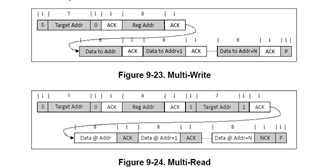Per the datasheet, the BQ25798 Ic supports multi-write and read as this:

but some of the registers are 1 byte, and others are 2 bytes, so in the multi-write (or read) transaction, after the first register address is sent, the following data to each of the register
would be either 1 byte or 2 bytes , but the chart above seems to be they are all 1 byte data. How this is handled?
Or say, the IC would accept all 1 byte data and recognize some of them are 2 bytes accordingly?

